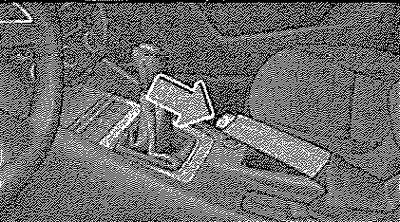Attention! When the engine is switched off, more force is required for braking! When braking on a vehicle with a manual gearbox, in gear, as well as when the engine is running at low speeds, it is necessary to press the clutch pedal. If this is not done, the brake booster may stop working! Never leave children in a car unattended. Children can release the parking brake or disengage the engaged gear. A / m can start moving! You need to make sure that this does not interfere with the ventilation of the front brakes and does not lead to their overheating. The front wheel brakes may overheat. which can adversely affect the operation of the braking system!
Brake Information
In the event of emergency braking, and when the brake system control unit evaluates the situation as dangerous for the following vehicles, the brake lights flash automatically. After the speed drops below 10 km/h or the vehicle comes to a stop, the brake lights stop flashing and the hazard warning lights come on. After the start of acceleration or when the movement is resumed, the emergency light signaling is turned off. Slow down and shift into a lower gear before driving down a long, steep downhill slope. This makes use of engine braking and reduces the load on the brakes. If additional braking is needed, do not keep the pedal depressed, but press it periodically.
Wear
The intensity of brake pad wear is largely determined by the operating conditions and driving style of the vehicle. If you frequently use your vehicle for short city trips or if you drive in a sporty manner, the brake pads wear out faster. In such more difficult conditions, it is necessary to additionally check the thickness of the brake pads in the intervals between passing the inspection service.
Moisture or road salt
When the brakes are wet, when the brake discs and brake pads are iced in winter, or when the discs and pads are covered with a layer of salt, braking occurs with some delay. To clean or dry the brakes, press the brake pedal several times.
Corrosion
Corrosion on the surface of the brake discs and contamination of the brake pads occur during long periods of inactivity and infrequent use of the vehicle. The brakes must be cleaned by repeated braking.
Brake system malfunction
If you notice that the braking distance has suddenly increased and the brake pedal has begun to sink deeper, this may indicate a malfunction of the brake system. Immediately go to the service station, being careful, because you do not know the true extent of the damage.
Low brake fluid
If the brake fluid level is too low, the normal operation of the brake system may be impaired. The brake fluid level is electronically controlled.
Brake booster
The brake booster amplifies the pressure that you create by depressing the brake pedal. The brake booster only works when the engine is running.
Parking brake

Pull the parking brake lever all the way up.
Unscrewing
Slightly raise the parking brake lever and at the same time press the lock button. With the lock button pressed, lower the lever all the way. When the parking brake is applied and the ignition is on, the contr. parking brake lamp
If you accidentally start driving with the parking brake applied, you will hear a warning chime. The instrument cluster display shows the following message: «M» Release the parking brake! «S» DISENGAGE PARKING BRAKE.
The parking brake warning will appear if you drive for more than three seconds at a speed of more than 5 km/h.
Attention! Make sure the parking brake is fully released. An incompletely released parking brake causes the rear wheel brakes to overheat. This can adversely affect the operation of the brake system!
